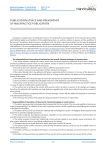Nanotechnologies in Construction: A Scientific Internet-Journal @nanobuild-en
Статьи журнала - Nanotechnologies in Construction: A Scientific Internet-Journal
Все статьи: 572
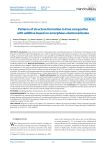
Patterns of structure formation in lime composites with additive based on amorphous aluminosilicates
Статья научная
Introduction. One of the reasons for coating destruction enclosing structures is the formation of condensate at the boundary of the fence and the finishing layer. As a result of external impact and freezing of moisture in the pores of the plaster coating, a network of small cracks is formed, and it is also possible to peel off the finishing layer. To test this hypothesis, the facades of three different buildings were examined. It is established that all the studied plaster coatings are made on the basis of cement mortar. It is also known that lime mixture is used less often due to the lack of sufficient resistance to moisture. Therefore, there is a need to increase the resistance of coatings based on lime compositions. This can be achieved by introducing an alumosilicate-based modifying additive into it. Materials and methods. Liquid sodium glass, aluminum powder PAP-1 and distilled water were used for the synthesis of the additive. Slaked lime (pushonka) with an activity of 84% was used to prepare test samples. Fritsch particle sizer Analysette 22 was used to analyze the granulometric composition of the additive. Compressive strength was determined on the samples measuring 20×20×20 mm. A testing machine of the type “IR 5057-50” was used for the study of compressive strength of samples. The analysis of rheological properties was determined by the Shvedov-Bingham equation. To study the plastic strength (ultimate shear stress) of the finishing mixture, a conical plastometer KP-3 was used. The plastic viscosity of the composition was determined with a rotary viscometer BCH – 3. Results and discussions. The synthesized additive is a light powder of light gray color with a bulk density of 0.55 ± 0.05 g/cm3. The synthesized additive revealed a high content of oxides Al2O3, SiO2, Na2O respectively, amounting to 51.03%, 36.36%, 11.89%. The additive consists of particles of 100.0–200.0 microns, which make up more than 20% of the total composition. The influence of an aluminosilicate additive on a lime binder on rheological properties was investigated, a slight increase in static shear stress was revealed, respectively, an increase in the percentage of the additive. The value of the dynamic shear stress increases significantly with an additive content of more than 10%. Conclusions. The regularities of hardening of a lime binder with a nanostructured additive based on amorphous aluminosilicates are established, and the optimal content of an aluminosilicate additive in the amount of 10% by weight of lime is determined.
Бесплатно
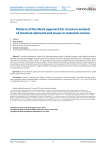
Статья научная
The authors developed a notion of the three-dimensional matrix of chemical elements, which made it possible to eliminate the main disadvantages of tabular forms of the structure of chemical elements developed by D.I. Mendeleev and the international community of IUPAC chemists. The three-dimensional structure is represented as an expanding conic matrix. At the same time, all known chemical elements up to number 118 are combined into four blocks. The block-structure made it possible to substantiate an electron-level formula, even for the proposed new chemical elements of the 5th block E with numbers 119 through 218. This allows for the development of a digital model for calculating interactions of chemical elements and obtaining new types of compounds and materials.
Бесплатно
Peculiarities of the formation of silicon oxide films modified with metal nanoparticles
Статья научная
Introduction. Silicon oxide film coatings have unique properties and are widely used in various industries, including construction. This paper presents the results on the preparation of polyalkylhydroxysiloxane liquid film in the presence of nanoscale particles of metallic bismuth. Methods and materials. Laser ablation method of metallic bismuth in aqueous medium was used to obtain bismuth nanoparticles. The surface of the target was treated with a laser beam at the workstation of an ytterbium pulsed fiber laser are discussed. The particle size and electrokinetic properties of colloidal bismuth sols were determined method by dynamic light scattering. After drying, Bi powder was added to polyalkylhydroxysiloxane liquid. Thin films cured under different heat treatment modes are applied to glass substrates by dipping. The resulting films were characterized by SEM, X-ray phase analysis, and FTIR spectroscopy. Results. In this work, the electrokinetic properties of colloidal bismuth sols are discussed. Laser ablation of a bismuth substrate leads to an increase in electrical conductivity and the appearance of a double electric layer in colloidal sols. The effect of the curing temperature on the properties of the coating is shown. It was found that the content of bismuth nanoparticles in the polyalkylhydroxysiloxane coating (3 wt.%) does not lead to the formation of crystalline phases. At the same time, the composition of the film and the mode of heat treatment affect the short-range order of molecular bonds. Increasing the content of bismuth nanoparticles in the coating of more than 10 wt.% leads to the appearance of microcrystalline phases of bismuth silicates in the system. Conclusion. The results obtained in the course of the study supplement the information about the production of bismuth nanoparticles by laser ablation and are of great importance in the practice of creating composite films.
Бесплатно
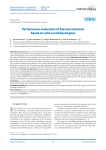
Performance evaluation of foamed materials based on cold-cured liquid glass
Статья научная
Introduction. The current trend of transition to non-combustible and environmentally friendly thermal insulation and sound-absorbing materials involves development of research to obtain foamed silicate compositions, particularly those based on cold-cured liquid glass. The primary advantage of this material is its eco-friendliness throughout both its operational and production stages, facilitated by the employment of energy-efficient manufacturing technology. Materials and methods. Cold-cured liquid sodium glass and cullet-based foam glass were used as main raw materials. To determine optimal curing additive of liquid glass, Portland cement, slaked lime and sodium ethylsilicate were selected. The thermal conductivity of materials was evaluated with by means of appropriate coefficient, value of which depended on volume content of pores in material, nature of porosity and distribution of pores by size. The decrease in water absorption capacity was estimated by value of wetting edge angle. Sorption humidity was determined in accordance with GOST 24816-2014, and sound absorption coefficient was determined according to GOST 16297-80. Results and discussion. The prime objective of this study was to examine trends and provide explanations for the formation of specified performance indicators of thermal insulation and sound-absorbing materials, particularly those based on cold-cured foamed liquid glass. The issue of increasing water resistance of material by selecting effective additive-hardener was also investigated. Conclusion. The developed thermal insulation material based on cold-cured liquid glass is eco-friendly, with presence of large number of small and mainly open pores, giving it good sound-absorbing properties. The problem of high-water absorption of material was solved by introducing Portland cement as a curing additive.
Бесплатно
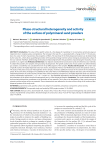
Phase-structural heterogeneity and activity of the surface of polymineral sand powders
Статья научная
Introduction. The value of the specific surface (Ssp), the degree of crystallinity (С, %) and surface activity (ks) plays an important role in creating various compositions. The increase in the size of Ssp is associated with a change in the “С” of rock powders, the value of which characterizes the properties of fillers. The reactivity of the finely dispersed material can be determined by the value of ks, which allows quantifying transition of the potential energy into free surface energy by activating the surface of the raw material. Therefore, determining the functional relationship between the parameters characterizing the reactivity of rock powders is an urgent task. Methods and Materials. Four deposits of polymineral construction sands are selected as raw materials. To obtain fine powders, the samples were ground by dry dispersion. The specific surface area of rock systems was determined by gas sorption. Crystallinity was calculated from the X-ray diffractogram of the samples. Results and Discussion. The certain sizes of specific surfaces for highly dispersed rocks have shown, that deposits “Kenica” and “Nekhtskoye” possess the greatest values Ssp. The study of the phase-structural heterogeneity of the samples, showed a significant increase of the content of the amorphous phase. At the same time, the degree of crystallinity for the sands “Kenica” and “Nekhtskoye” deposits decreases 25%. The functional relationship between the surface activity and the shares of the amorphous component (c) for highly dispersed sands was characterized by mathematical expression ks = 21•10–6•c+0,58•10–6. The identified dependence demonstrates the relationship between the parameters of the phase-structural heterogeneity and ks of fine-dispersed samples. Conclusion. The results obtained showed that mechanical dispersion contributes to the activation of raw materials. This is due to the breakability of the crystal structure of minerals and the texture of the raw materials. These characteristics are reflected in the value of the activity of the surface of finedispersed systems of the rocky rocks.
Бесплатно
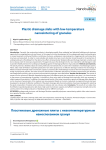
Plastic Drainage Slabs with low-temperature nanosintering of granules
Статья научная
Introduction. Currently, the construction industry is developing rapidly. New residential and industrial buildings and structures appear both in megalopolises and small towns. In this regard, an active development of the underground space continually gains in scope: basements and buried facilities, multistorey structures, underpasses and parking lots, shopping malls and many other structures are being built. In order to create reliable and durable structures much attention should be paid to the protection of underground parts of buildings from the destructive effects of groundwater. Waterproofing and drainage materials currently used do not always meet the necessary requirements. The paper discusses the development of a new material for wall drainage in order to provide reliable protection for underground buildings against the damaging influence of groundwater. Methods and materials. The article presents a detailed analysis of existing methods and materials that are used in the installation of wall drainage systems. Plastic slabs made of filtration expanded polystyrene have been proposed as an effective drainage material. The technology of filtration material with high water transmission capacity is presented. This methodology is based on the low-temperature nanosintering of polystyrene granules. The main structural characteristics of filtration polystyrene, including characteristic pore diameter and intergranular porosity, and its physical and mechanical properties were determined. Results and discussion. The results of research on the structure of filtration expanded polystyrene with different grain-size compositions are given. It is shown that due to the process of nanosintering of granules it is possible to form varies types of drainage slab structures, which are necessary to obtain required characteristics. In addition, the experimental results of the water transmission capacity of drainage slabs, depending on the structural characteristics of the material, are also presented. Based on the tests conducted, an empirical formula has been developed to calculate the filtration coefficient of the plastic drainage slabs. Recommendations have been developed for selecting the grain composition of material when working on cohesive and non-cohesive soils. Conclusion. The results of our study show that filtration expanded polystyrene slabs have a high-water transmission capacity and sufficient compressive strength and can be used to protect the underground parts of buildings based on different soil types.
Бесплатно
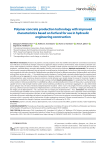
Статья научная
Introduction. Research of polymer concrete properties show that it differs favorably from conventional concrete by such indicators as mechanical strength, resistance to aggressive impact of various environments, water resistance, abrasion resistance, water-repellency and frost resistance. Currently, it is possible to obtain polymer concrete with characteristic and chemical properties –specified density, strength, deformability, ductility, and corrosion resistance. Methods and materials. The research is carried out by comparing laboratory tests of polymer concrete based on furfural binder. Furfural has a high reactivity and can form resin compounds with many chemicals. Diphenylamine was added to furfural in different proportions. Benzenesulfonic acid, sulfuric acid and their mixture at a ratio – 1:1 by weight were used as hardeners. Crushed sand or ground andesite based on nanostructured microfiller served as aggregate for various compositions of polymer solutions. The polymer concrete strength, chemical resistance, lasting properties, water resistance, abrasion resistance, metal adhesion were tested during the research. Structural changes in properties were studied by the electron microscopic analysis method. Results and discussion. It is established that the diphenylamine solution in furfural, provided that it is solidified by sulfuric acid, benzolsulfoacid or mixture of these acids, is a polymer binder capable to form a high-strength material under normal hardening conditions by acid-resistant aggregates. It is also determined that to prepare resin, the ratio of furfural and diphenylamine should be within 1:0.5–0.3 by weight. The resin containing 1 weight part (w.p.) of furfural and 0.5 weight part of diphenylamine is conventionally named FD-1; containing 1 weight part of furfural and 0.4 weight part of diphenylamine – FD-2 and resin with 0.3 weight part of diphenylamine – FD-3. Conclusion. The introduction of nanostructured microfiller into the polymer concrete composition could save expensive resin. Comparison of the technologies for producing FD resin and polymer concrete, as well as preliminary test data of the studied materials, can determine the possible technical and economic advantages of polymer concrete based on FD resin over the polymer concrete based on FA (furfurolacetone) monomer which is currently used in construction of hydro-engineering structures. Polymer concrete based on FD resin has high strength and exceeds the strength of polymer concrete based on FA monomer by 20–25%.
Бесплатно
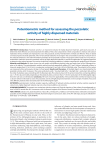
Potentiometric method for assessing the pozzolatic activity of highly dispersed materials
Статья научная
Introduction. Pozzolatic activity is an important indicator for highly dispersed materials, particularly clay soils. It determines their effective use and characterizes the ability of the active components in their composition to interact with calcium hydroxide. Various methods are employed to assess this pozzolatic activity. Potentiometric methods are effective. They are based on measuring the electrode potential, which is functionally related to the change in the concentration (activity) of calcium ions in the analyzed solutions as the main information parameter of the pozzolatic reaction. The purpose of the research is to test the potentiometric method to assess the pozzolatic activity of highly dispersed materials, as well as the application of suggested approach to determine the rational amount of an active mineral lime-containing additive as a binder component for producing soil-concrete. Materials and Methods. We have chosen clay soil models with different plasticity index and sandy loam of the Arkhangelsk region as the objects. The potentiometric analysis method involved sequentially adding 0.015 mol/l calcium hydroxide solution, in amounts ranging from 0.2 to 0.8 ml, to a suspension containing 0.5 g of soil in 80 ml of distilled water. The potential of the system was measured while continuously stirring at a fixed speed. Results and Discussion. All studied objects are characterized by the pozzolatic activity, which increases in the series sandy loam sandy → clay loam light silty → clay light silty ≈ sandy loam silty and has the order of absolute values coinciding with the literature data. The rational amount of the active mineral lime-containing additive was 1–2% for clay soil models, depending on the plasticity index, and more than 2 % for the sandy loam of the Arkhangelsk region (from the soil mass on dried basis). Conclusion. We have shown the applicability of the potentiometric method of analysis using a calcium-selective electrode to assess the pozzolatic activity of highly dispersed materials on the example of models of clay soils with different plasticity index and sandy loam of the Arkhangelsk region.
Бесплатно
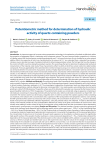
Potentiometric method for determination of hydraulic activity of quartzcontaining powders
Статья научная
Introduction. An important aspect of concrete mixture preparation technology is the exploration of methods to effectively utilize the properties of aggregates (fillers) in hardening multi-component systems. The most common binder composition is a mixture of a binder system with crushed quartz-containing polymineral sand. It is known that micro silica is classified as an active mineral additive (filler), the properties of which are characterized by the amount of Ca2+ ions absorbed from a saturated lime solution. Literature sources describe two types of analytical methods for determining pozzolanic activity. The first type that trace the change in the content of Ca(OH)2 over time during the pozzolanic reaction. The second type that aim to determine the physical and mechanical characteristics of the material under study. These characteristics reflect its ability to bind free calcium oxide into stable hydrate compounds. Previously applicability of the potentiometric method of analysis using an ion-selective electrode with pCa-function was demonstrated for the assessment of pozzolanic activity of highly dispersed materials. It should be noted to note that this electrochemical method of analysis which is functionally related to the concentration of the determined component in the tested solution, is very efficient in terms of expressiveness and labour intensity. The objective of the research is to validate the method for micro silica systems obtained by mechanical grinding of raw materials of polymineral sands from different deposits. The experiments were conducted using sands from the Arkhangelsk region deposits. The quartz sand (QS) was chosen as a reference object to establish the nature of change in the functional relationship of the measured potential of the electrode system from the volume of added Ca(OH)2 solution. Methods and Materials. The polymineral sand of the Krasnoflotsky-West deposit is categorised as alluvialmarine modern Quaternary sediments (am IV). The sand of the Kholmogorskoye deposit is quartz-feldspathic sand, which belongs to alluvial modern Quaternary sediments (a IV). The mineralogical composition of polymineral sands was determined by means of the semi-quantitative method, utilising the binocular microscope MBS-1. Fine sand powders were obtained by dry mechanical grinding in a Retsch PM100 planetary. The specific surface area of the obtained fine powders was measured by the Kozeny-Karman gas permeability method on a PSKh-10a apparatus. The potentiometric analysis was conducted using an apparatus comprising an electrode pair, consisting of a measuring electrode with pCa-function and a reference electrode connected to an Expert-001-3.0.1 ionometer. The reaction system was stirred using a magnetic stirrer. In order to ascertain the sorption capacity of silica-containing raw materials, a lime solution with a concentration and a suspension of fine sand powders were prepared in advance. Concurrently, the EMF (potential) of the system was measured, with constant stirring. The concentration of calcium ions, Cact, was then calculated based on the previously established calibration dependence, using the potential values (mV) obtained. In order to determine the activity of fine mineral powders of silica, the dependence between the values of the given concentration of calcium ions in lime solution when adding a certain volume of lime to the suspension of the studied sands and the concentration values obtained by potentiometric measurements was plotted. Results and Discussion. The obtained powders of quartz-containing polymineral sands, which had been finely dispersed, had the following specific surface values: quartz sand – 1020±31 m2/kg, Krasnoflotsky West – 465±14 m2/kg and Kholmogorskoye – 450±14 m2/kg. The given data on the specific surface of powders of natural origin allow for a comparative analysis of experimental potentiometric measurements. Concurrently, the dependence of the measured potential on the concentration of calcium ions in the solution for quartz sand suspension can be utilised as a reference, given the significantly high specific surface of the powder, thereby resulting in a more pronounced dependence E = f(Vadd). Relationship obtained the dependence of the measured potential of the electrode system on the volume of added Ca(OH)2 solution in a suspension of quartz sand (as a reference sample) and distilled water (as an idle experiment) shows that the nature of the change in the functional relationship of the analysed two samples (QS and H2O) is different. Concurrently, it can be observed that the incorporation of a lime solution into water (in accordance with the anticipated outcome) results in a nearly constant augmentation in the measured potential values, the magnitude of which is proportional to –lgCCa. Change of potential of electrode pair in suspension of quartz sand powder has character different from that mentioned above for water.
Бесплатно
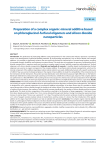
Статья научная
Introduction. The production of plasticizing additives using nanoparticles for the construction industry represents a promising sector in the development of advanced building materials. By incorporating nanoparticles, such as silicon dioxide, into complex additives, it is possible to significantly enhance the structural and mechanical characteristics of cement-based systems, resulting in increased strength, durability, and resistance to external forces. This study aims to investigate the process of synthesizing silicon dioxide nanoparticles in aqueous media and creating a complex organic-mineral additive comprising phloroglucinol- furfural oligomers with silicon dioxide nanoparticles. Materials and methods of research. A modifier based on phloroglucinol-furfural oligomers was used as an organic component of the complex additive. To synthesize silicon dioxide nanoparticles, which are the mineral component of the additive, liquid glass (sodium silicate solution) was used. Additionally, Aerosil, with a specific surface area of 2,000 m3/kg, was used as the dispersed phase in the organic mineral additive to study the compatibility of the components and the mechanism of their interaction. The particle and size distribution were determined using laser light diffraction on the Malvern Mastersizer 3000 device and dynamic light scattering on the Microtrac S3500 device. Microscopic analysis of the complex additive was performed on a TESCAN MIRA 3 LMU scanning electron microscope. The chemical structure and composition of the obtained additive were monitored by UV and IR spectrophotometry on Specord 200 Plus and Alpha Bruker Optics devices, respectively. Results and discussion. The article presents the results of the development of a method for the synthesis of silicon dioxide nanoparticles and creating an organic-mineral additive based on phloroglucinol-furfural oligomers containing these nanoparticles. The additive is designed for use in mineral suspensions in construction additive technologies. It has been shown that it is possible to obtain nanoscale particles of silicon dioxide through the hydrolysis of sodium silicate. It has been demonstrated that as the concentration of sodium silicate increases, the number of silica particles increases significantly, the number of silicon dioxide particles increases significantly. This leads to faster coagulation of the particles, resulting in the formation of larger aggregates. It has been shown that silicon dioxide particles smaller than 10 nm can be obtained through acid titration. During the maturation period, particles increase in size by about 7 times over a period of 1 to 7 days. The optimal ratio for particle synthesis should be considered to be a 2:1 ratio of reagent solutions (sodium silicate to hydrochloric acid) by volume. It is shown that the introduction of the specific additive at the stage of particle formation can help to stabilize their growth. Conclusion. The complex organic-mineral additive based on a phloroglucinol-furfural oligomer and silicon dioxide nanoparticles has been developed. It has been established that the introduction of the specific additive in the process of synthesis of silicon dioxide particles contributes to an increase in the aggregate stability of the dispersed system of the complex additive, reduces the tendency of particles to enlargement and sedimentation.
Бесплатно
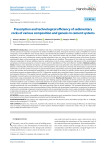
Статья научная
Introduction. Active mineral additives that allow controlling the structure formation processes and properties of cement systems are important components of modern modified concretes. Among the numerous types of modifiers for cement composites, the most effective ones include siliceous and aluminosilicate additives containing a significant amount of nanoscale particles, in particular, nanoparticles of silicon dioxides, clays, aluminum oxides and iron oxides. At the same time, common sedimentary rocks, such as diatomites, trepels, opokas, polymineral clays, etc., along with industrial wastes (silica fumes, fly ashes, metallurgical slags) can be promising raw materials for obtaining such modifiers. The purpose of this study was to establish the influence regularities of mineral additives based on sedimentary rocks of various composition and genesis on the technological and physico-mechanical properties of cement systems with the identification of the most effective modifiers. Methods and materials. Siliceous rocks (diatomite and opoka), calcined polymineral clays and carbonate rocks (dolomite and chalk) from several deposits of the Republic of Mordovia were used as mineral additives. The study of the chemical and mineralogical composition of sedimentary rocks was carried out using X-ray spectral fluorescence spectrometry and X-ray powder diffraction methods. In addition to the chemical and mineralogical composition, at the initial stage of the study, the specific surface area of mineral additives and Portland cement was determined on the PSX-12 dispersion analysis device using the Kozeny-Carman method. Prescription and technological efficiency of the applied mineral modifiers was evaluated by their effect on water demand, water-holding capacity, flowability of cement paste and mixed cement binder activity. The physical and mechanical characteristics of cement systems were determined using standardized and well-known authorial methods. Results and discussion. There were established correlation dependences between indicators of water demand, water-holding capacity, flowability of cement systems and specific surface of mineral additives used. In addition, relationship between the activity index of the studied modifiers and the content of silicon dioxide in their composition was revealed. Conclusions. According to the totality of the conducted studies, diatomite, opoka and calcined polymineral clay were identified as the most promising types of mineral additives. The increased effectiveness of these modifiers in cement systems is due to the peculiarities of their chemical and mineralogical composition, in particular, the presence of active silica-containing components (reactive minerals with an amorphized structure) such as opal-cristobalite-tridymite phase in diatomite and opoka as well as products of partial thermal destruction (dehydroxylation) of minerals of kaolinite and illite groups in the calcined polymineral clay.
Бесплатно
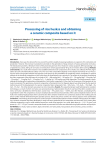
Processing of rice huskss and obtaining a ceramic composite based on it
Статья научная
Introduction. Every year, the demand for rice around the world is steadily increasing, leading to an expansion of its cultivation and production. However, this increase in production also leads to the generation of large amounts of waste, particularly rice huskss. The introduction provides a literature review of the processing and use of rice huskss for various purposes. When producing 1 ton of polished rice, about 200 kg of rice huskss is formed, from which approximately 40 kg of ash remains after burning. Methods and materials. As a result of the research it was established that the main components of rice huskss are: cellulose (40-45%), lignin (about 20–25%) and hemicellulose (about 15%). The rest of the composition depends on the deposit and variety of rice. Processing rice huskss using hydrocavitation and pyrolysis units opens up new possibilities for producing ceramic composites. A spectral analysis of the chemical composition of rice husks from the Suzak district was carried out. The results of the analysis showed that the main component of the solid mass of rice husks is SiO2 – 400 mg/kg, MnO – 195 mg/kg, K2O – 120 mg/kg, MgO – 30 mg/kg, CaO – 20 mg/kg, P – 13 mg/kg, Na2O – 3.9 mg/kg, Fe2O3 – 3 mg/kg, Ag – 0.04 mg/kg, and other impurities. The article presents a methodology for studying the composition and properties of rice huskss components. A flow chart for the process of fast pyrolysis of rice husks is presented. The preliminary chemical composition of bentonite from the Tegerek deposit was determined by the spectral method as part of the development of a ceramic composite. Main components: SiO₂ – 50%, Al₂O₃ – 12%, Fe₂O₃ – 12%, MgO – 4%, CaO – 3%, K₂O – 2%; other elements are present as minor impurities. Results. The experimental part used hydrodynamic cavitation technology, as a result of which rice huskss was processed using a hydrocavitator. Results: It was found that after cavitation treatment, rice husks is divided into three fractions: coarse mass – 75%, plastic mass – 15.83%, and a fine fraction, constituting 9.6%, suspended in water. The composition, structure and physical and technical characteristics of the coarse and plastic fractions of rice husks were studied. Rapid pyrolysis of the coarse fraction after cavitation treatment was carried out. Based on the resulting ash and silicon-carbon material formed during the pyrolysis process, dense and porous ceramics for various purposes were synthesized. Conclusion. A technology for processing rice huskss using the created hydrocavitator and the method of fast pyrolysis for obtaining a ceramic composite has been developed. A study has been conducted of the composition and structure of rice huskss after cavitation treatment, as well as solid residues formed as a result of fast pyrolysis. As a result, both dense (ρ = 1.19–1.22 g/cm³) and porous (ρ = 0.51–1.02 g/m³) ceramic composites based on processed rice husks were obtained using hydrocavitation and pyrolysis.
Бесплатно
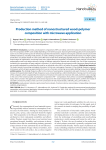
Production method of nanostructured wood-polymer composition with microwave application
Статья научная
Introduction. Currently, wood-polymer compositions (WPC) are widely used in the national economy and construction. The composition of WPC varies widely depending on the further purpose. Improving the binding quality in the wood-polymer system is one of the promising areas for enhancing operational characteristics. Organic and inorganic substrates nanostructured with individual substances, including metal particles, are used as binding components. In the petrochemical industry, most high-capacity productions use catalysts based on active carriers like heavy metals when developing targeted products for various purposes. After several stages of regeneration, recovering these heavy metals becomes impossible. Consequently, spent catalysts accumulate in sedimentation tanks and sludge collectors, lacking an efficient method for disposal and secondary use. One of the components included in the composition of spent catalysts is chromium (+6), which belongs to carcinogenic metals. Numerous disposal methods are currently inadequate for neutralizing this metal on an industrial scale, which is of interest for research. Methods and materials. The study is aimed at converting carcinogenic chromium (+6) into non-carcinogenic chromium (+3) by ultrahigh frequency exposure (microwave), which will open up opportunities for its use as a chromium-containing nanocomplex binding a tree-polymer. Results and discussions. The ultrahigh-frequency effect on the mixture of wood-polymer composition and spent chromium (+6) causes an increase in the penetration depth of high–frequency waves, characterized by a uniform distribution of energy over the entire area of the composite, which is explained by the reduction of chromium (VI) oxide into chromium (III) oxide, and there is also a change in the color of the nanostructured wood-polymer composition (WP – compositions) from yellow to malachite. Conclusion. This study, which consists in the application of microwave exposure to the wood-nanoparticle-polymer system, confirms the receipt of a durable construction product and its use in the construction of roofs, facade boards, sidewalks, piers, port facilities, etc.
Бесплатно
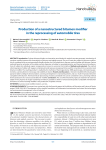
Production of a nanostructured bitumen modifier in the reprocessing of automobile tires
Статья научная
Introduction. Polymer-bitumen binders are innovative nano-binders for asphalt concrete pavement. Introduction of a polymer modifier improves the characteristics of bitumen and asphalt concrete. The use of waste tires rubber for bitumen modification is considered to be an environmentally friendly solution, but it is limited due to the poor cosite of rubber with bitumen. Various methods based on activation of the rubber surface, dispersion of rubber to nanosized particles, and thermochemical transformations of rubber into individual organic compounds are known to overcome this limitation. Methods and materials. The method of joint pyrolysis of rubber with oxygen-containing oil under pressure is proposed to be used for converting it into a nanostructural bitumen modifier. The resulting product is studied by the methods of thermogravimetry, NMR-spectroscopy, chromatomasspectrometry, scanning electron microscopy and solubility in toluene. Results and discussion. It has been established that during joint pyrolysis rubber undergoes devulcanization, cracking and dispersion to nanosized particles, and as a result the product becomes compatible with bitumen. Thermochemical reprocessing of waste automobile tires can be considered to be a promising method for the production of a nanostructured bitumen modifier. Conclusion. The use of thermochemical pressure treatment of waste tire rubber in the presence of oxygen-containing oil makes it possible to obtain a nanostructured product compatible with bitumen for further use of the resulting modifier in the production of asphalt concrete.
Бесплатно
Статья научная
Introduction. In the article we analysed the technology for producing silicon from rice husks. The analysis showed that the production of polycrystalline and amorphous silicon based on rice waste in the form of rice husk solves the simultaneous disposal of rice waste. Rice husk processing produces valuable organic products, and the residual solid waste mainly contains silicon, carbon and other trace metal elements. Therefore, obtaining silicon and silicon-containing materials from rice husk is relevant. Methods and materials. Various methods for obtaining silicon from rice husk are given. Among them, the methods of chlorination and sublimation were chosen, and experimental installations were assembled to conduct the experiment. The object of study was samples obtained from rice husks of Uzgen rice in the Kyrgyz Republic. Results. The composition and structure of rice husks for the production of crystalline silicon were studied. Lime milk was used to purify toxic chlorine-containing gases in the air of the working area and atmospheric air. The condensing system, designed to capture volatile chlorides, has two receivers. In the first receiver at a temperature of 60°C, condensation of iron, aluminum and magnesium chlorides occurs. It has been established that highly volatile silicon (IV) chloride (SiCl4) at a given temperature remains in the gaseous phase and is completely distilled off in the next receiver of the refrigerator. This indicates that the silicon is in the form of SiCl4 (60°C) and condenses only at a lower temperature in the next receiver. The data obtained indicate that when the temperature rises to 200°C, the process of chlorination of metal compounds initiates. The optimal conditions for maximum extraction of metals and silicon tetrachloride from rice husk were identified: temperature 500–550°C and time 120 minutes. Non-volatile chlorides of calcium, sodium, potassium and other elements form a floating mixture at 450°C. During the reaction, metal chlorides harden and settle on the cold walls of the reactor. Therefore, at this temperature there is not enough heat to maintain them in a gaseous state, and they condense to form solid precipitates. Lime milk containing CaO – 130 g/dm2 is a very effective and cheap means for purifying toxic chlorine-containing gases in the air of the working area and atmospheric air. At high temperatures (1050–1100°C), it is possible to activate chemical reactions between the carrier gas (hydrogen) and silicon chloride (SiCl4), which promotes the decomposition of SiCl4 into components, including silicon and hydrogen chloride, and also provides certain conditions for the formation and deposition silicon crystals. Conclusion. A technology for producing polycrystalline silicon by chlorination from rice husks of Uzgen rice of the Kyrgyz Republic has been studied and developed.
Бесплатно
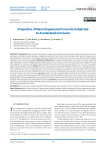
Properties of Nano Engineered Concrete Subjected to Accelerated Corrosion
Статья научная
Introduction. Many research had worked on improving the performance of concrete subjected to severe environment and improve concrete corrosion resistance. Using nano-materials is one of the methods had been used recently to improve concrete properties. In this research, a comparison between the performance of nano-silica and nano-clay in enhancing the durability properties of concrete was investigated. Methods and Materials. The experimental program was carried out through examining water absorption, water permeability, rapid chloride penetration test, corrosion resistance, bond strength of steel rebar before and after subjected to corrosion, and finally microstructure test. Nano-silica and nano-clay were added at 1%, 3%, and 5% as a partial replacement by weight of cement. Results. Both nano-silica and nano-clay showed significant performance in reducing the permeability and porosity of concrete and improve corrosion resistance of concrete. For comparison, nano-clay had a significant impact than that of nano-silica on concrete properties; in which the water permeability resistance of nano-clay mixes was enhanced by 87% than that of the control mix, while for nano-silica, it was 51% only. The chloride ion penetration was reduced by 72% for nanoclay mixes, while in nano-silica was 28%. Discussion. Nano-clay had a significant effect than that of nano-silica on the concrete durability properties; the flat-shaped of nano-clay particles had improved the microstructure of the cement matrix through the damping effect, besides the filling effect through the microstructure of the matrix which reduces the chloride ion penetration and improves water absorption and permeability of concrete. Conclusion. The optimum percentage of nano-silica is 1% by weight of cement as a partial replacement of cement by weight. However, for nano-clay is 5%, which gives the best performance in improve the durability properties of concrete.
Бесплатно

Properties of porous heat-resistant composition materials. Part I
Статья научная
This article is a continuation of a series of articles on the production of porous composite nanomaterials. This paper presents an overview of the properties of porous, heat-resistant inorganic composite materials. The physicochemical and mechanical characteristics of various porous refractory materials produced industrially are presented. A separate class of materials with a regular and quasi-regular porous structure is considered. Such materials include the so-called cellular or «lattice» materials, that are becoming widely applied in modern industry. An example of such materials is ceramic foam – a sintered ceramic material with a foamy cellular structure. A special group of materials with opal pore structure has been also focused. Synthetic opals have received intensive development in recent years because they are model objects for the development and research of new spatial-periodic structures with nonlinear optical properties. Such structures include composites based on classical and inverted opals, in which the pores are filled with various dielectric, semiconductor, or metallic substances. The optical properties of these systems are determined by the size of the close-packed particles, as well as the dielectric constant of the components.
Бесплатно
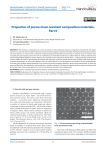
Properties of porous heat-resistant composition materials. Part II
Статья научная
This article is a continuation of a series of articles on the production of porous composite nanomaterials. This paper presents an overview of the properties of porous, heat-resistant inorganic composite materials. The physicochemical and mechanical characteristics of various porous refractory materials produced industrially are presented. A separate class of materials with a regular and quasi-regular porous structure is considered. Such materials include the so-called cellular or «lattice» materials, that are becoming widely applied in modern industry. An example of such materials is ceramic foam – a sintered ceramic material with a foamy cellular structure. A special group of materials with opal pore structure has been also focused. Synthetic opals have received intensive development in recent years because they are model objects for the development and research of new spatial-periodic structures with nonlinear optical properties. Such structures include composites based on classical and inverted opals, in which the pores are filled with various dielectric, semiconductor, or metallic substances. The optical properties of these systems are determined by the size of the close-packed particles, as well as the dielectric constant of the components.
Бесплатно

